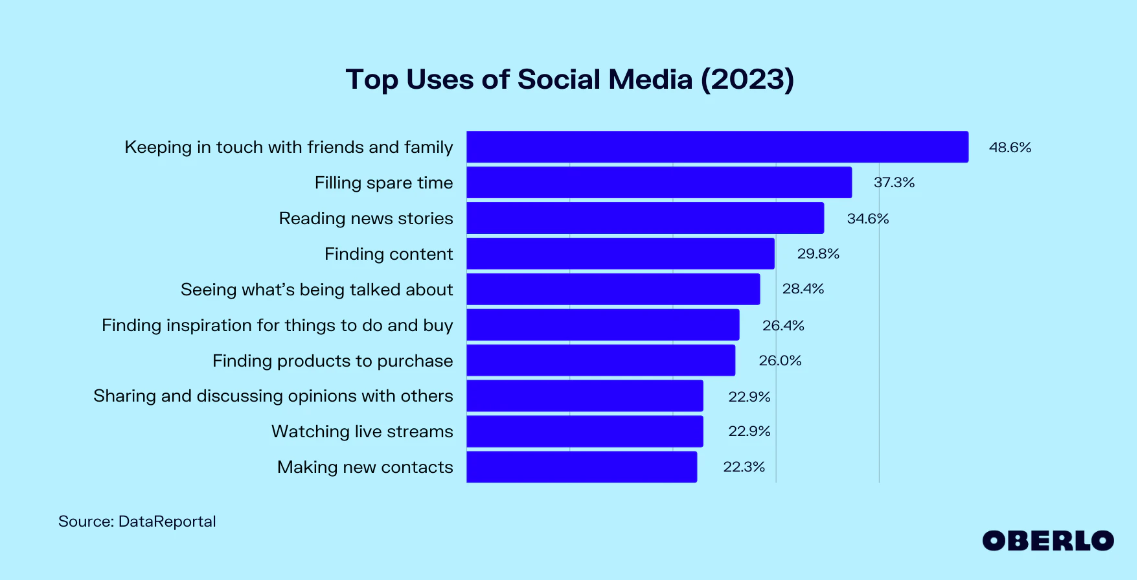Social media is a necessity when it comes to communication for modern churches. But how do you brainstorm new church social media post ideas seven days a week, every month of the year?
Are you worried that your local church’s social media team is burning out? (Or maybe you are the team and are concerned about your personal well-being!)
We know that it can be tough to keep up with your content strategy with constantly changing trends, algorithm updates, and new platforms. So in this post, we have a 31-day plan that provides a month’s worth of church social media post ideas. This post also covers staying ahead of the game, creating a winning social strategy, and engaging your online community.
Estimated reading time: 15 minutes
Table of contents
How to Create Your Church Social Media Post Strategy

It can feel overwhelming to move into the modern digital age. You’re still trying to figure out your church website, and now you have to focus on social media too?! Over time, it’s draining to come up with church social media post ideas on the fly. That makes it challenging to stay on top of your game strategically and creatively.
The solution is to create a social media content plan. Planning won’t fence you in – it allows you to be more creative.
Here are a few quick steps to formulating your strategy.
Preparation Strategy Tips
- Define Your Goals and Objectives: Start by identifying the specific goals and objectives you want to achieve through your social media presence. These could include increasing attendance, fostering community engagement, promoting events, sharing inspirational messages, or attracting new members. Knowing your leadership team’s priorities and expectations will help you determine what kind of content to focus on.
- Understand Your Target Audience: Know who you are talking to, what platforms they utilize, and when they’re engaging. Understand their preferences, interests, and needs to tailor your content accordingly.
- Research What Other Churches Are Doing on Social Media: You don’t want to be a copycat, but it can be helpful to see what’s working for others and gather new ideas. We’ll go more in-depth on using these free resources in the next section.
- Choose the Right Platforms: Decide which social media platforms are most suitable for your church. Common platforms for churches include Facebook, Twitter, Instagram, and YouTube. Focus on the ones where your audience is most active.
- Create a Content Calendar: This is where you’ll map out what kind of content will go on which platform and when. You can check out the 31-day plan below to help you get started with a month’s worth of ideas!
- Determine Who Will be Creating Social Media Content: In most cases, you will need help with photos, graphic design, videos, writing captions, posting, and monitoring engagement (i.e., responding to comments. Do you have enough staff members and volunteers to cover, or do you need to outsource?
- Develop a Posting Schedule: Determine how often you’ll post on each platform and at what times. Consistency is key to keeping your audience engaged. Use scheduling tools or apps to help you post at the right times even when you’re busy.
Active Strategy Tips
- Encourage User Engagement: Actively encourage likes, comments, and shares on your posts to increase your reach. Ask questions, run polls, or host interactive Q&A sessions.
- Monitor and Respond: Regularly check your social media accounts for comments and messages. Respond promptly and engage in conversations with your followers. Address any concerns or questions they may have.
- Don’t Forget Hashtags: Use relevant hashtags to increase the discoverability of your social media posts. Research popular hashtags in your niche and create unique ones for your church events and campaigns.
- Analyze and Adjust: Use analytics tools provided by social media platforms or third-party tools to track the performance of your posts. Pay attention to metrics like engagement, reach, and follower growth. Adjust your strategy based on what works best for your audience.
- Collaborate and Partner: Collaborate with your local church community, organizations, or community groups to cross-promote events and initiatives. This can expand your reach and strengthen your community ties.
- Stay Authentic and Positive: Maintain a positive and authentic voice in your social media posts. Reflect the values and mission of your church in all your content.
Once you have a solid social media strategy, it’s time to fill in your content. But first, let’s have a quick word on navigating social media trends as a church.
Keeping Up with Social Media Trends

Rest assured, somebody out there is busy developing the next greatest social media platform as you read this. That may excite you . . . or make you feel even more overwhelmed.
Staying up to date with social media changes, up-and coming platforms (hello TikTok), and the ever-increasing content you need to produce can be tons of pressure, but it doesn’t have to be if you maintain the right mindset.
Social Media Trend Ideas
- Follow Influential Accounts and Pages: Identify and follow social media pages, accounts, and influencers that regularly share information about current trends in your niche or industry. This can help you stay informed about what’s popular and relevant.
- Use Trend-Tracking Tools: Utilize trend-tracking tools and platforms like Google Trends, Trendspottr, and social media listening tools (e.g., Brandwatch, Hootsuite) to monitor trending topics and keywords in social media posts.
- Stay Active on Social Media: Consistent activity on a social media platform or two will expose you to trends more naturally. Scroll through your feed regularly, engage with content, and explore hashtags.
- Subscribe to Newsletters and Blogs: Subscribe to newsletters and blogs that cover social media trends and digital marketing. Many industry experts and publications regularly share insights and updates.
- Engage in Trending Hashtags: Keep an eye on trending hashtags on platforms like Twitter and Instagram. Participating in relevant conversations using these hashtags can increase your visibility.
- Experiment and Adapt: Don’t be afraid to try new things on social media. Experiment with different content formats, such as live streaming, stories, or reels, to see what resonates with your audience. Be willing to adapt your strategy based on what works.
- Collaborate with Influencers: Partnering with social media influencers can help you tap into current trends and reach a broader audience. Influencers often have their fingers on the pulse of what’s hot in their niche.
- Monitor Analytics: Regularly review your social media analytics to see which types of content perform best. Adjust your strategy to create more of what resonates with your audience.
- Engage Authentically: While staying on top of trends is essential, ensure your engagement and content align with your brand’s voice and values. Authenticity is key to building trust.
Social Media Tips
Here are some tips to keep in mind while monitoring social media trends and creating social media posts.
- You don’t have to be on every platform all the time. Figure out where your target audience is most active, and concentrate on the 2-3 most popular media (or even one) for your church to get momentum.
- Most social media platforms are copying each other. That’s good news because it means the same short video will work for Instagram, TikTok, and YouTube Shorts (and possibly others). Simply customize your video with an AI video editor to fit the size requirements and specifications and post it on different platforms.
- You can repurpose content. Take a blog post, turn it into an infographic or short video, and share that across multiple platforms. Or you can also take a recorded sermon and create social media posts with quotes or critical points to continue the conversation online.
- Be consistent. This also means you should be realistic about the amount of content you can post regularly while maintaining a high level of quality.
- It’s not always what you say; sometimes, it’s how you say it. Posting an inspiring quote from last weekend’s sermon isn’t an innovative idea, but people still love it. Instead of trying to come up with off-the-wall ideas 24/7, focus your creative energies on fresh ways to present standard content people enjoy (memes aren’t going anywhere!). For example, design an edgy new graphic or use a trending reel format.
- Video is essential right now. Although you can mix it up, video will get the most views.
Social Media Videos
A further note on videos: you don’t need full-scale video production and professional editing for every social media post. Video can be simply a reel with phone footage, a series of photos strung together as a video, or an informal recording of someone talking into a phone.
Remember that people crave authentic connection. And videos give a complete picture with verbal and non-verbal layers of communication. Also, they’re more entertaining and engaging.
31-Day Plan of Church Social Media Post Ideas

The outline below will help you map out a month’s worth of content for your staff members to work on. Be flexible with this plan, however. First, adapt it to work for you, depending on the day of the week the month starts and your specific events and ministries.
A 31-Day Social Media Plan for Churches
- Weekend service video recap
- Notes/outline from weekend message for further study
- Highlight a church serve/volunteer team
- Graphic of upcoming events for the week/month
- Teaser video for your upcoming sermon series
- Showcase children’s ministry and what kids experience each weekend
- Time for church! Show people arriving for service
- Share a powerful sermon clip
- A reminder of the church’s mission, vision, values
- Highlight a small group and encourage people to join one
- Scripture on prayer + ask how you can pray for people
- Selfie video from the upcoming weekend speaker about what they’re excited to share
- Highlight youth ministry events, services, etc.
- Sunday service worship set list + worship highlights
- Quote from a weekend sermon
- Testimony from a volunteer or Small Group member
- Upcoming service/outreach/missions project
- Funny meme: find something applicable to a sermon series or upcoming event
- Invite post: encourage members to bring someone to church + graphic invite
- Behind-the-scenes weekend prep (kids, auditorium, worship, etc.)
- Video of someone sharing their biggest service takeaway
- Outreach service project recap + highlight wins
- Share a corporate prayer request (government, education, crisis, etc.)
- Inspiring quote
- Throwback: vintage photos or videos from early on in your church
- Service promo: Looking forward to the weekend because…
- Generations/family focus: Highlight different age groups as part of one church family
- Weekend live “man on the street” POV during church service
- Practical tips: how to apply sermon series/faith principles to daily life
- Post a funny Christian comedy clip/sermon clip
- Baptism highlight + info on upcoming baptisms
You may also substitute or add in reminders for events your church does weekly or monthly, such as:
- Mid-week adult or youth service
- Prayer meetings
- Serve projects
- Monthly or quarterly baptism
- Women’s/Men’s night or Bible study
- Special events and holidays
- Guest speakers
Content Pillar Topics for Church Social Media Post Ideas

Content pillars are commonly used in digital marketing and are the topics you feature regularly. First off, they provide an easy way to come up with social media post ideas that are relevant and engaging.
However, content pillars do more than help you brainstorm and organize your church’s social media post ideas. They also help you build a consistent message and recognizable church brand. Your “brand” isn’t just your graphic design; it’s your identity and mission.
Focusing on a few key content pillars will help you tell the story of who you are, what you value, and what you do as a church.
Your content pillars may be event-based like
- Weekend service
- Small groups
- Youth events
- Outreach projects
Or, they may be more topical or value-based. You might focus on prayer, community, the gospel, and discipleship. Then, you take events, services, and ministries and focus on how they relate to the overarching values.
Tips on Using Content Pillars
Utilizing content pillars is a strategic approach to content creation and organization that helps maintain consistency, relevance, and effectiveness in your content marketing efforts. Here are some key notes on how to effectively use content pillars:
- Identify Your Content Pillars: Start by identifying 3-5 main content pillars that are central to your brand or organization. These should represent the core areas of expertise or themes that your content will revolve around.
- Align with Audience Interests: Your content pillars should align with the interests, needs, and preferences of your target audience. Understanding your audience is crucial to selecting the right pillars.
- Maintain Consistency: Content pillars provide a consistent framework for your content strategy. Regularly create and share content within these pillars to build a cohesive and recognizable brand identity.
- Diversify Content Types: Each content pillar can support various types of content, such as blog posts, videos, infographics, podcasts, and social media updates. Diversify your content formats to cater to different audience preferences.
- Content Mapping: Create a content map or calendar that outlines which types of content will be created under each content pillar. This helps you plan your content in advance and ensures a balanced approach.
- Keyword Research: Conduct keyword research to identify relevant keywords and phrases within each content pillar. Incorporate these keywords naturally into your content to improve search engine visibility.
- Internal Linking: Link related content within the same pillar to improve user engagement and SEO. This encourages visitors to explore more of your content.
Ideas for a Discipleship Content Pillar
For example, if discipleship is a content pillar, you might share:
- A post about how to study the Bible effectively
- A testimony from someone who has recently been discipled by another church member
- Highlights from a new small group that is starting up
- A video clip on what it looks like to be a disciple of Christ
- The definition of discipleship from Church leaders
- Tips on how to be a good disciple
- The benefits of discipleship
- How church members can get involved in discipleship
Ideas for a Community Content Pillar
Below are a few more church social media post ideas. For example, if community is one of your pillars, you might share:
- Testimonies from people who have found community at your Church
- Quotes about the importance of community
- Scriptures on relationship and community
- How to get plugged into a small group or ministry team
- Highlights from a Church-wide event
- A behind-the-scenes look at what volunteers do as part of a team
- Photos focused on people interacting with each other at services and events
These are just some examples of how you can expand on a topic. Let’s cover one final lens you can use when creating your social media content pillars.
How Do You Serve Your Social Media Community?
Here’s another way to view content pillars: how do you serve your audience with your social media content? This is an essential question because it’s easy to get caught up in promoting your Church and forget that social media is a two-way street.
Your content should be 80% informative, helpful, or entertaining and 20% promotional. That means for every ten posts; eight should be focused on something other than asking your audience to do something for you (like serve, sign up, or attend).
According to Oberlo, the top reason people use social media is to stay in touch with family and friends (47.6% of users).

So, do followers perceive your church as “family and friends” or as a business trying to promote something to them?
The type of content you release will determine how they perceive your church, so consider how you can create content that serves. Here are five principles.
Inspiration
Your content should be inspirational. This means giving people hope, a reason to believe, and a way to see the world differently.
One church started a social media campaign called “I Believe.” Every day, they would post an inspirational message or story on their social media channels with the hashtag #ibelieve. This was an excellent way for them to serve their community and inspire hope.
Engagement
Your content should also be engaging. This means creating content people want to interact with, share, and comment on.
You can ask questions, post polls, and release quizzes. You could also create interactive graphics or videos. For example, you could ask people to submit their requests for weekend worship songs.
Entertainment
Your content doesn’t always have to be serious. In fact, it shouldn’t be! You should also release content that makes people laugh, smile, or feel good.
One church created a series of short, funny videos called ” Church Fails.” Each video would show a clip of something going wrong during a church service or event. This was a great way to engage their social media community and make them laugh.
Connection
Finally, your content should connect with people personally and help them communicate in real life (or IRL). Not only are you creating content that resonates with their emotions and speaks to their personal needs, but you should also focus on how they can connect with other people in the church.
You could do this by featuring personal stories from Church members, sharing tips on how to get involved in the Church community, or releasing graphics that show the different ways people can get involved.
Information
Although inspiration and entertainment are fun, people rely on social media for news and updates. So, you can use social media to let people know what events are coming up or direct them to sign-ups or web pages with more information.
While you don’t want your social media to be a non-stop event promotion billboard, updates are helpful for your members.
Church Social Media Ideas

So, how do you put all these principles into practice? It starts by looking at your Church’s mission and goals, creating a plan, and establishing your content pillars. Then, the sky is the limit regarding church social media post ideas! Use the 31-day social media calendar to help you start planning.
We’d love to hear your thoughts; share your favorite creative social media idea below!





Comments 2
This blog post is a treasure trove of valuable insights and practical tips for church social media management. Thomas Costello does an excellent job of breaking down the complexities of social media strategy into manageable steps. The comprehensive 31-day plan is particularly impressive, offering a roadmap for consistent and engaging content creation.
I appreciate how the post addresses the challenges faced by church social media teams, such as burnout and keeping up with changing trends, while providing actionable solutions. The emphasis on authenticity, engagement, and serving the community resonates deeply and aligns perfectly with the core values of church ministry.
The inclusion of examples and real-life case studies adds depth to the discussion and makes the concepts more relatable. Overall, this article serves as a valuable resource for anyone involved in church social media management, offering both inspiration and practical guidance for building a vibrant online presence. Well done!
Your church’s dedication to preserving and celebrating cultural traditions, music, and art is a testament to the rich tapestry of human expression. Your organization creates a space where creativity and cultural diversity are celebrated and embraced.